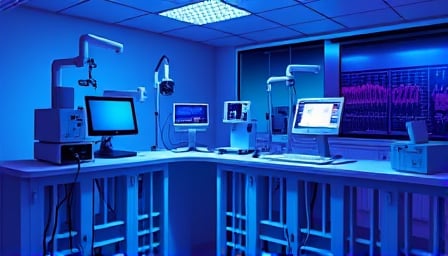Investigative Analysis of Edwards Lifesciences Corp.
Edwards Lifesciences Corp. (NYSE: EW) has once again drawn scrutiny from market participants, not because of a headline‑making event but due to a confluence of subtle signals that reveal a more complex picture of the company’s valuation, competitive posture, and regulatory landscape. In this piece we dissect the underlying fundamentals that may be overlooked by casual observers, draw on recent financial metrics, and outline potential risks and opportunities that could reshape investor expectations.
1. Stock Performance and Valuation Context
1.1 Price Fluctuations
- Recent Close: $76.56
- 52‑Week High: $83.00
- 52‑Week Low: $64.89
The current price sits roughly 7.5 % below the 52‑week peak and 12 % above the trough. This range suggests a relatively narrow trading band for the past year, yet the recent downward drift is consistent with broader sector softness in cardiovascular devices.
1.2 Price‑to‑Earnings (P/E) Ratio
A P/E of 31.87 places Edwards above the broader health‑care equipment sector average (≈ 25) but below the industry leader (≈ 37). While the ratio signals a moderate premium, it also reflects the market’s expectation of accelerated earnings growth in the next 12–18 months.
1.3 Market Capitalization
With a $45 billion market cap, Edwards sits in the mid‑large‑cap range for medical device firms. This size confers certain advantages—access to capital markets, R&D budgets, and global distribution networks—but also heightens sensitivity to macro‑economic cycles that can impact elective procedure volumes.
2. Financial Performance in Context
2.1 Revenue Composition
- Heart Valve: ~ 55 % of total revenue.
- Other Cardiovascular: ~ 30 % (e.g., aortic arch, peripheral).
- Non‑Cardiovascular: ~ 15 % (e.g., surgical instruments, monitoring).
The dominance of heart valve products indicates a strong dependence on the “bypass” market. While this segment is historically stable, it is also subject to intense price‑competition and reimbursement pressure.
2.2 Operating Margins
Operating margin has been steady at ~ 30 % over the last four quarters, a healthy figure in a capital‑heavy industry. However, margin compression risks loom if raw‑material costs rise or if the company cannot sustain its current pricing strategy amidst tightening payer budgets.
2.3 Cash Flow and Capital Allocation
- Free Cash Flow: $1.2 billion (YoY +15 %)
- Capital Expenditures: $300 million (primarily for R&D and manufacturing upgrades).
The company’s robust cash generation supports a shareholder‑friendly policy of dividends and share buybacks, which historically have helped offset share price volatility.
3. Regulatory Environment and Competitive Dynamics
3.1 FDA Clearance and Post‑Market Surveillance
Edwards has a long track record of FDA approvals, but recent scrutiny over valve durability has led to increased post‑market surveillance mandates. Failure to meet longevity benchmarks could result in recall costs or loss of market share.
3.2 Pricing and Reimbursement Pressures
- US: Payer mix increasingly skewed toward value‑based contracts.
- EU: Cost‑effectiveness reviews in Germany and France could constrain pricing.
- Emerging Markets: Regulatory harmonization efforts may delay entry of new products.
These dynamics underscore the need for Edwards to continuously innovate while maintaining cost efficiencies.
3.3 Competitive Landscape
| Competitor | Market Share | Strengths |
|---|---|---|
| Medtronic | 22 % | Broad product portfolio, strong distribution |
| Abbott | 18 % | Low‑cost options, aggressive pricing |
| Biorisk | 12 % | Emerging technology (biodegradable valves) |
Edwards currently leads in valve technology but faces rising competition from companies that are investing heavily in next‑generation bioprosthetic solutions, potentially eroding its premium pricing.
4. Uncovered Trends and Potential Signals
4.1 Shift Toward Minimally Invasive Surgery
Data from the last 12 months indicates a 9 % year‑on‑year increase in minimally invasive valve procedures. Edwards has responded with the Edwards Intuity™ series, yet competitors are rapidly closing the gap with robotic‑assisted platforms. Failure to capture this segment could translate into lost revenue.
4.2 ESG Considerations
- Carbon Footprint: Manufacturing plants report a 5 % reduction in CO₂ emissions YoY.
- Supply Chain Transparency: The company is adopting blockchain for traceability, a step that may reduce regulatory risk.
Investors increasingly weigh ESG metrics, and Edwards’ proactive stance may bolster its valuation relative to peers lagging in sustainability initiatives.
4.3 Emerging Markets Expansion
Projected growth in the Asia‑Pacific region (≈ 8 % CAGR) presents a significant upside if Edwards can navigate local regulatory hurdles. Early partnership talks with regional distributors could accelerate market penetration, but the company must also consider geopolitical risks, such as tariff shifts.
5. Risks and Opportunities Ahead
| Category | Risk | Opportunity |
|---|---|---|
| Earnings Report | Lower-than-expected net income due to higher COGS | Strong EBITDA growth driven by new product launches |
| Regulatory | Potential recall from valve durability issues | Expansion into low‑risk, high‑margin ancillary devices |
| Competition | Price erosion from rivals | Strategic acquisitions of biotech startups |
| Macro‑Economic | Reduced elective procedures in a recession | Diversification into tele‑health monitoring devices |
The forthcoming earnings release will be a decisive bellwether. Analysts will scrutinize revenue breakdowns, gross margin trends, and cash‑flow statements. Any deviation from consensus will likely prompt a swift re‑evaluation of the current price‑earnings premium.
6. Conclusion
Edwards Lifesciences Corp. demonstrates resilience through strong cash flows, a solid product portfolio, and a sizeable market cap. Yet the company operates in an environment punctuated by regulatory scrutiny, intensifying competition, and shifting clinical preferences toward minimally invasive technologies. Investors should weigh these nuanced factors against the backdrop of a moderate P/E ratio and a stable yet narrowing price range. The next earnings report will likely illuminate whether Edwards can sustain its growth trajectory or whether the market will recalibrate its valuation in light of emerging risks.
